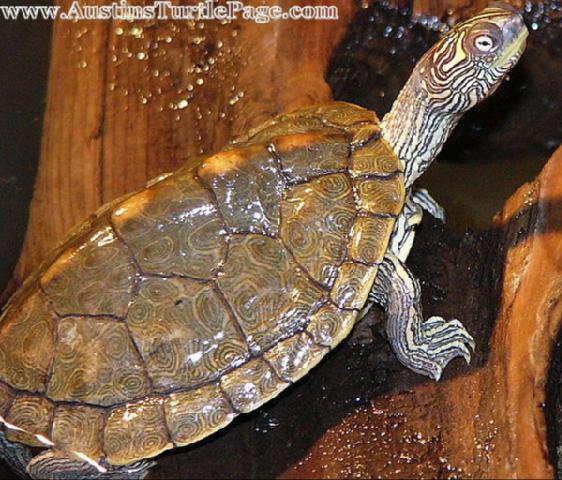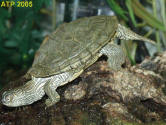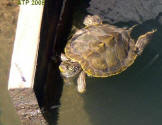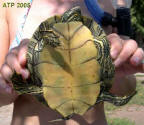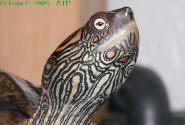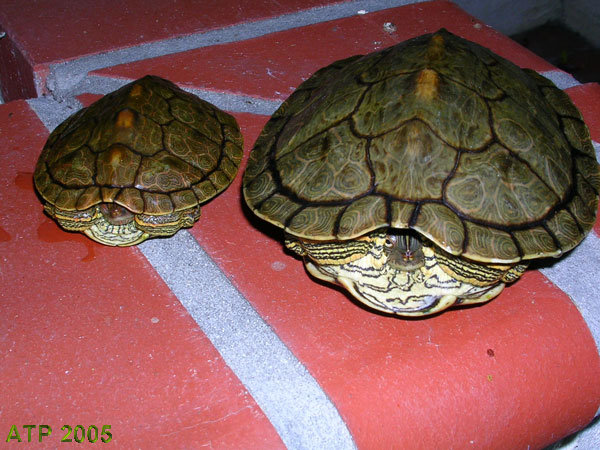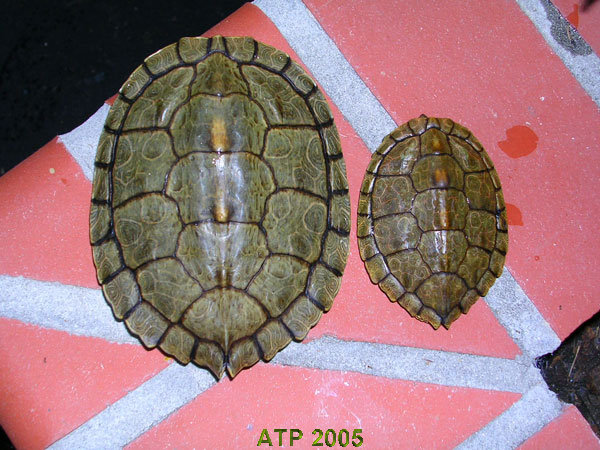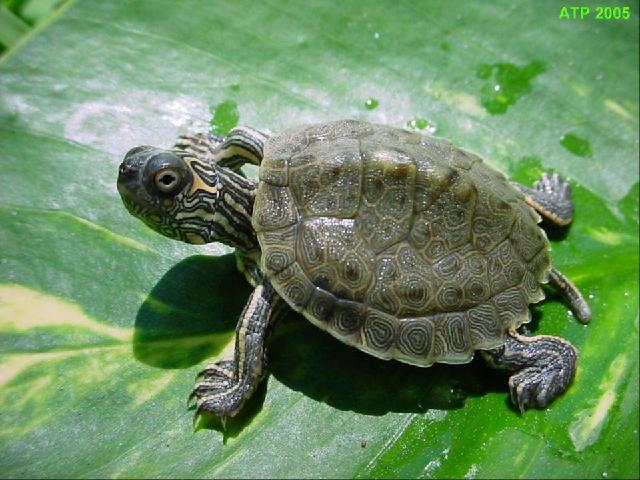|
|
|
|
||||||||||||||||||||
|
Graptemys versa
|
||||||||||||||||||||||
|
|
|
|||||||||||||||||||||
|
|
|
|
||||
|
General - A small-to-medium semi-aquatic basking turtle with the typical map turtle elliptical-shaped body shape, a keeled carapace (the fairly flat sides rise to the spinal keel, like the roof on most U.S. houses) with a single row of small knobs down the back. Hatchlings are rounder. As per all map turtles they can withdraw into the shell but cannot close the shell for protection. Males have a longer, broader-based tail with vent distal to the carapace edge (in adults); females have proportionately shorter, thinner tails. Male Texas maps lack longer foreleg claws (unlike male painteds, sliders & cooters). Carapace - One of distinguishing features of map turtles is the keel (peak) running along the spine with a single row of small 'knobs' along it, & a jagged rear carapace edge (unlike the black-knobbed map, whose entire carapace perimeter is serrated). The carapace is typically olive to brown with intricate yellow to orange whorls surrounded by wider, light road-like lines (reminiscent of a road map); these patterns often fade with age & may be obscured by algae overgrowth. Texas map turtles don't have black-tipped knobbing (unlike Mississippi & Black-Knobbed maps), & their knobs are small. Their skin is extensively (yellow) striped; the overall effect is grey to dark skin with long yellow stripes. Note: Map turtles in general are prone to algae overgrowth of the carapace. Plastron - The plastron is tan to yellowish with dark seams between scutes. Juveniles may exhibit dark patterning which fades with age (some adults have a faint 'dark cloud' pattern on the plastron). It's hingeless & so cannot close to protect the turtle. Head - The head of the Texas map is a key identifying feature. Stereotypically a horizontal yellow line behind the eye sends a crescent curving over part of the eye, but this bar may be broken. Many have a vaguely J-shaped post orbital mark but the appearance varies greatly amongst individuals. Another distinguishing feature is the round pupil & bright iris with a partial bar across the pupil (unlike Mississippi maps). On the underside of the lower jaw are yellow spots (typically one at the chin, & more further back). Although technically grouped with the narrow headed map turtles, adult female Texas maps actually have moderately broad heads (comparable to Northern, Mississippi & Cagles maps) (Lindeman9). Size - Females are much larger than males (as is typical for maps). The male being ~ 2 3/4" to 4 1/2” and the female anywhere from 3 1/2” to nearly 8 1/2” SCL (sizes adapted roughly from figures given in Turtles of the United States and Canada1).
Map turtles get their name from the lines and markings on their carapace which resemble the contour lines of a map. Sex can be determined by examining the tail. |
||||||
|
|
|
|
|
|
|
|
They occur in the Colorado River drainage on the Edwards Plateau of south-central Texas. At ITTN affliate Graptemys.com5 Chris Lechowicz notes they occur in both relatively fast-moving, muddy rivers & also streams, creeks & lakes connected to the river system; some of these creeks are clear & include fast flow, waterfalls, rocky bottoms & deep pools. Lechowicz notes like other map species they're fond of brush piles. Lindeman8 noted the South Llana River is a clear, spring-fed river with alternating riffles & pools (they live here, too). Lindeman6 researched the relationship of size & dietary preference on habitat use (note: in map turtles generally females are much larger, prefer to utilize deeper water habitat with swifter current & may eat more larger, harder shelled mollusks - particularly in the broad-headed species, although the Texas map is a narrow-headed map), & concluded prey distribution is the likely determinate of habitat preference (smaller females, while roughly the size of adult males, are thought to have a diet more similar to larger female Texas maps than male maps (females eat more mollusks)). Texas Memorial Museum at UT Austin has an online distribution map. |
||
|
|
|
|
|
|
|
||||
|
TEMPERATURE RANGE (°F)
Male Texas Maps are fine beginner turtles; females are more medium-sized but still acceptable. They are reputed to be amongst the least skittish & most poor water quality-tolerant map turtles to keep (individuals vary; map turtles as a class have a reputation for being skittish & prone to problems in poor quality water) but overall care is the same as sliders & painted turtles (albeit high water quality may be even more important). Females get larger, up to 8.5", and can be a strain on housing. CAPTIVE DIET Texas map turtles are omnivores (but thought to be predominantly carnivorous). We've limited research data on the diets of wild Texas maps; Lindeman7 indicated females partake of a more strongly molluscivorous diet (even those of the same size as adult males); one item on the menu is the invasive Asian clam. Even at the same size females tend to have wider jaws & crushing surfaces of the mouth7. In other research Lindeman8 noted mollusks were abundant in the diet of 28 females studied; insects were abundant in the diet of males with one group of 25 males predominantly feeding on soft-bodied aquatic invertebrates (esp. trichopteran larvae), & another group of 7 also containing aquatic insect remains. Like all map turtles Texas maps lack the rapid strike capability of chicken turtles & young common snapping turtles, the sheer speed of softshell turtles & the lure of alligator snappers, & there is no basis to believe they take in much fish in the wild. Given their predominant carnivory that leaves a diet mainly of invertebrates (i.e.: aquatic insects & insect larvae, aquatic snails, etc...). Experience with captive Texas map turtles suggests even males enjoy snails, although they require small snails with fairly weak shells they can crush. Note 1: Snails of the genus Goniobasis have been implicated in transmitting the lung fluke Heronimus mollis to loggerhead musk turtles10, & the snail Physa integra identified as an intermediate host for H. mollis11, 12 & both it & Physa gyrina are natural intermediate hosts13. Lung flukes do infect other turtle species, including Midland Painted Turtles & Common Snappers. Aquatic snails are well-known as intermediate vectors of a range of parasites affecting a range of animal species, so we at Austin's Turtles Page do not recommend feeding wild-caught snails, or snails bred in containers with wild (or otherwise at risk to be infected) turtles present, to pet turtles. The extent of the danger of parasitism is theoretical & unclear. Some people do feed their pets wild-caught snails. Note 2: We have an anecdotal report of a young stinkpot being trapped & drowned by a freshwater clam, so be wary of larger shellfish. They’re easily over-fed protein resulting in an unhealthy growth rate and pyramiding of the shell. They readily eat live foods such as crickets, grasshoppers, earth worms (red wrigglers are small & thin enough to use - chop up for juveniles), small aquatic snails, bloodworms, Krill, other small shrimp (including ghost shrimp), small fresh-killed fish (i.e.: guppies & rosy reds) & commercial dry foods such as Mazuri and ReptoMin. They also eat some vegetation such as Romaine lettuce & the water plant Anacharis. RECOMMENDED FEEDING SCHEDULE Start hatchlings on once daily feeding of commercial pellets or carnivorous fare up to about 6 months. At this age, a diet of good brand name pellets (i.e.: ReptoMin, Mazuri; you may occasionally substitute some live foods) is recommended. Feed just enough to reduce appetite, but don’t let them gorge themselves (2 'Baby ReptoMin' pellets/day the first few weeks of life is a good start). After 6 months or so cut back on the feedings to every other day. Adjust amount of food at accordingly with growth rate & shell appearance. Romaine lettuce may be offered ‘all you can eat’ at any age (romaine is mostly water, & not apt to overload them on protein). Other lettuces are fine, too (they may have less fiber & even less nutritional content than Romaine, though the latter shouldn't be an issue if the rest of the diet is sufficiently nutritious). Organically grown lettuce is preferred to avoid pesticide residues. Note: Overfeeding high-protein foods causes rapid growth, shell deformities (pyramiding) & is believed harmful to the liver & kidneys. If the carapace scutes develop a prominent concentric ring pattern &/or thicken, making the carapace bumpy, cut back strongly on protein in the diet or your turtle will have a permanently pyramided shell. That said, some juvenile map turtles (this is known in Mississippi & Black-knobbed maps) may develop widened seams ('gaps') between the carapace scutes during growth. If these become pronounced cut back on feeding, but mild seam widening isn't alarming. CAPTIVE HABITAT They are avid swimmers and baskers. They need a good basking area where they can get totally out of the water and get completely dry (including the plastron; the basking platform must dry out, not remain wet/damp). This area will not only need a radiant heat source (i.e.: standard incandescent bulb or ceramic heat emitter), but ideally a source of UV-B (UV-B lighting is strongly recommended, especially if you aren’t confident dietary Vitamin D3 is sufficient & for growing hatchings). This is accomplished with lighting (usually either a UV-B fluorescent such as a ReptiSun 5.0 for UV-B & a separate basking lamp for heat; some UV-B mercury vapor bulbs (i.e.: Mega-Ray, T-Rex Active UV-Heat, ZooMed PowerSun) are an option). Being avid swimmers they need plenty of swimming room, both vertical and horizontal. Map turtles as a class have a reputation for being more prone to health problems if high water quality isn’t maintained, although this is reputedly less of an issue for Texas maps. RECOMMENDED ENCLOSURE A single small-to-medium adult male (maybe 2) would do fine in a 29 gallon enclosure, but a large female will need at least a 55 gallon enclosure to insure adequate space. A basking area can be made of driftwood, smooth or flat rocks, or anything else non abrasive, non toxic, and capable of supporting the weight of the turtle. The basking area should be large enough for the turtle to get the entire body out of the water and dry. Strong filtration is recommended to maintain high water quality. A submersible heater to ensure water temp.s don’t drop far is recommended, preferably with a heater guard to reduce burn risk. Substrate isn’t critical but a complex landscape to explore could include river rock (but take care the turtle isn’t apt to strike hard objects diving off the basking platform). To add additional Texas (or similar-sized) maps to a habitat we recommend you increase the size of the tank accordingly by ~ half (i.e.; 1 or 2 males = 29 gallons+, 3 males or 1 or 2 females = 55 gallons+, etc). The larger the enclosure the better. Stock tanks also make great alternatives to glass and acrylic aquariums. If your map is one of the skittish ones, consider placing the enclosure in a less traveled area (i.e.: spare bedroom) to reduce stress. WATER DEPTH Map turtles are excellent swimmers and will do better in deeper waters. Even as hatchlings they prefer (relatively) deeper setups, albeit with plenty of cover for security. COMMUNITY HABITAT Mississippi map turtles are usually good community turtles. Being of a more timid nature they seldom show aggression. As with other turtle species, aggression may occur among males competing over a female to mate, & sexual harassment of females by males (& retaliation by females) may become troublesome enough to warrant separation. |
||||||
|
|
|
|
|
|
|
|
Paul V. (Chelidman) reports egg clutches can be from 2 to 8 eggs (typically 4 to 5) & take between 45 and 60 days to hatch (depending on temperature). While map turtles in general exhibit TSD (temperature-dependent sex determination), we've found no reference for what the temp. cut-offs are for mostly male, mixed & mostly female batches of eggs. Generally speaking, incubating map turtle eggs at cooler temp.s produced males, warmer temp.s produce females, & intermediate temp.s mixed hatches. Paul surmised Texas maps may tend toward fairly warm incubation temp.s in light of their native range. Incubation times for turtle eggs tend to be shorter when temp.s are warmer. Chelidman uses much the same approach for Texas maps he uses for most turtle species' eggs (except those requiring diapause). Paul uses damp sphagnum (not peat!) moss for substrate, creates shallow depressions for the eggs with his thumb (note: unlike chicken eggs, you don't turn turtle eggs - it can kill them), & they go in a plastic food storage container (i.e.: Tupperware, Rubbermaid, Sterilite) with ventilation holes punched in it. He used a Hovabator incubator but when the ambient temp.s exceed 85º F he unplugs it & just uses it for the isothermic properties of the Styrofoam shell. If his turtle egg #'s (he's a breeder) get into the hundreds he sometimes uses a large Styrofoam fish shipping box. Most of his Spring/Summer clutches get incubated at a semi-natural day/night cycle ranging from 78º F at night to 88º F by day, & he's found this approach yields stronger, more robust hatchlings in most species. |
||
|
|
|
|
|
|
|
||
ENCLOSURE Even as hatchlings they are adept at swimming in deeper water and a hatchling's habitat has proportionately the same requirements as that of an adult. For very small hatchlings (around 50 cent piece-sized) open with around 6 - 8 inch water depth & increase over a few weeks.) Use the same type of lighting (UV-B & also heat.) We recommend additional plants (live or artificial) and other items protruding from the water surface. This gives the young hatchling additional hiding places as well as more places to rest; wild hatchling turtles are vulnerable & secretive, so plenty of cover is preferable to an ‘open water’ habitat. Due to the sensitivity and a fairly high mortality rate of turtle hatchlings in general, water temps should be kept warmer than adults, between 78° and 80°F. DIET They do well on a quality commercial turtle food such as Mazuri or ReptoMin periodically varied with ‘whole-prey’ foods (i.e.: worms, crickets & fresh-killed fish). Vegetation (i.e. Romaine lettuce & Anacharis) should be offered, although some don't take to them until they are older. Youngsters may or may not take to commercial foods. If they do not take in food known to contain Vitamin D3 (typically commercial foods), be sure to provide UV-B lighting & supplemental calcium. Bloodworms are fine for coaxing reluctant feeders but nutritionally insufficient for a staple. Finely shopped small earthworm bits, freshly killed & crushed guppies & small feeder crickets & grasshoppers are fine choices. Hatchlings are shy & fragile so don’t try feeding outside the tank until at least several weeks of well-being feeding in the tank (if you do this at all). |
||||
|
|
|
|
|
|
|
|
1.) Austin's Turtle Page - our central information base & teaching site for general aquatic turtle care. 2.) Designing Your First Turtle Enclosure - our ATP article on planning a freshwater aquatic turtle setup, including different size classes, budget options & cost. 3.) Crash Course in Baby Water Turtle Care - A concise setup guide for people who have a hatchling water turtle (including maps) in hand & need to get a starter setup together right now. 4.) Rubbermaid Tubs vs. Aquariums as Enclosures - exploring a budget option for people keeping juvenile on up to smaller adult male Common Maps. 5.) Choosing Your First Turtle - please read thoroughly before you buy. Common Map turtles aren't the best starter turtle for everyone, & there are excellent options such as male Texas maps, male southern painted turtles & stinkpots who stay smaller & have similar care requirements. 6.) Concise Guide to Choosing North American Turtles as Pets - a 'window shoppers' guide' to what's out there, with photo.s & basic facts. 7.) Where to Get a Turtle - an article introducing you to the market & how to get what you're after. 8.) Filtration - get up to speed on mechanical, biological & chemical filtration & the popular aquarium filter models keepers are using. Also check out ATP Product Reviews - Filters, and our Comparison of the FilStar XP3, Fluval 404 & Eheim Pro II 2028 large canister filters. 9.) ATP Guide to UV-B Lighting - if you want to really get into this complex topic. 10.) What to Keep with Turtles - a review of animals & fish you might try with your turtle. 11.) The Basking Spot Page - a multi-page article at our ITTN affiliate ATP Habitats, discussing both commercial basking platform products & ways to make your own. 12.) Pet Warehouse - a reputable major online superstore for pet supplies. You can often get higher priced items like canister filters, ReptiSun 5.0 & 10.0 UV-B tube bulbs & ceramic heat emitters at drastic savings over retail. 13.) That Pet Place - a reputable major online superstore for pet supplies. You can often get higher priced items like canister filters, ReptiSun 5.0 & 10.0 UV-B tube bulbs & ceramic heat emitters at drastic savings over retail. 14.) Big Al's Online - a reputable major online superstore for pet supplies. You can often get higher priced items like canister filters at drastic savings over retail. 15.) Reptile Direct - a smaller yet reputable online pet store widely popular for rock bottom prices. 16.) Herp Supplies - A smaller yet reputable online pet store I've found useful for surprising odds & ends like a 2 foot pair of tweezers, backgrounds, steel heaters & other things. 17.) The Center for Disease Control (CDC) Disease Information Page on Salmonellosis. This link opens the General Info. Page, but click on the Technical Info. & Additional Info. tabs for more information. 18.) The Center for Disease Control (CDC) Salmonella (Salmonellosis) Infection and Animals Fact Page. 19.) Pet Owners Beware: Reptiles Can Cause Salmonella Infections - WebMD article by Andrea Braslavsky from Nov. 10'th, 1999. Includes specific CDC recommendations. 20.) World Chelonian Trust's Map Turtle Care Sheet - our ITTN affiliate's general care guide for map turtles. 21.) Map Turtles of the United States. David Kirkpatrick, Ph.D. Reptile & Amphibian Magazine, Nov/Dec. 1993, pg 6-17. 22.) Graptemys.com - our ITTN affiliate devoted to map Turtles. Here's the Texas Map page. Site owner Chris Lechowicz. 23.) ATP World of Turtles Texas Map Photo Gallery - a collection of photo.s, both captive & wild. BIBLIOGRAPHY 1.) Turtles of The United States and Canada. Carl H. Ernst, Jeffrey E. Lovich and Roger W. Barbour. Smithsonian Institution Press, Washington and London. ©1994. (Possibly the preeminent natural history text of North American turtles – not a care guide but very highly recommended). 2.) A Field Guide to Reptiles and Amphibians of Eastern and Central North America. 3'rd Ed., Expanded. Roger Conant & Joseph T. Collins. Houghton Mifflin Company. South New York, New York. (Probably the most prestigious field guide on the topic covering this large area. Not a care guide, but highly recommended). 3.) Keeping and Breeding Freshwater Turtles. Russ Gurley. Living Art Publishing. P.O. Box 321, Ada, Oklahoma, USA 74821-0321 www.livingartpublishing.com. 300 Pages. ©2003. 4.) Practical Encyclopedia of Keeping and Breeding Freshwater Turtles and Tortoises. A. C. Highfield. Carapace Press. 295 Pages. ©1996. 5.) Graptemys.com - an online site specializing in information pertaining to Graptemys turtles. An ITTN affiliate. 6.) Lindeman, P. V. (2003). Sexual differences in habitat use of Texas map turtles (Emydidae: Graptemys versa) and its relationship to size dimorphism and dietary differences. Canadian Journal of Zoology, 81, 1185-1191. 7.) Lindeman, P. V. (2003).Aspects of the Life History of the Texas Map Turtle (Graptemys versa). The American Midland Naturalist: Vol. 153, No. 2, pp. 378–388. 8.) Lindeman, P. V. (2001). Investigations of the Ecology of Graptemys versa and Pseudemys texana in Southcentral Texas. Chelonian Conversation and Biology, Vol. 4, No. 1, pp. 223-224. 9.) Lindeman, P. V. (2000). Evolution of the relative width of the head and alveolar surfaces in map turtles (Testudines: Emydidae: Graptemys). Biol. J. Linn. Soc. 69:549-576 (Cited in 8.), above). 10.) Cox, William A., Steven T. Wyatt, Walter E. Wilhelm and Ken R. Marion. (1988). Infection of the Turtle Sternotherus minor, by the Lung Fluke, Heronimus mollis: Incidence of Infection and Correlations to Host Life History and Ecology in a Florida Spring. Journal of Herpetology. Vol. 22, Number 4, pp. 488-490. 11.) Ulmer, M. J. and S. C. Sommer. (1957). Development of sporocysts of the turtle lung fluke, Heronimus chelydrae MacCallum (Trematoda: Heronimidae). Proc. Iowa Acad. Sci. 64:601-613. Cited by 10.), above. 12.) Crandall, R. B. (1960). The life history and affinities of the turtle lung fluke, Heronimus chelydrae MacCallum, 1902. J. Parasit. 46:289-307. Cited by 10.), above. 13.) Ulmer, M.J. (1960). Physa sayii, a new intermediate host for the lung fluke Heronimus chelydrae (Trematoda: Heronimidae). J. Parasit. 45:813-814. Cited by 10.), above.
Special Thanks to Thomas Coy, Chris Lechowicz, Paul V. (Chelidman), Wendy (Turdle)
& Barry Lambert
for providing content for this care sheet.
|
||
|
|
|
